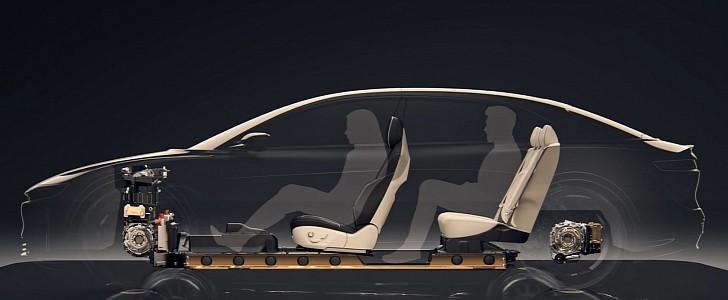Fiat used to have a motto for its cars: only 20% of space available in a vehicle should be dedicated to the mechanical bits. The other 80% were for passengers and luggage. Lucid does not seem to have a similar philosophy. Despite that, Peter Rawlinson showed how making the most of the available space helped the Air achieve ambitious goals.
At first, the only benefit would be to offer more room to the EV’s occupants and their stuff. The Lucid CEO said the Air presents "the interior space of a German grand marquis automobile" – the video shows the shape of a Mercedes-Benz S-Class – and "the handling dynamics of a sports car." However, a more compact powertrain also makes the vehicle lighter, which is crucial for an EV to achieve longer ranges. Lucid managed to create a drive unit that comprises the motor, the inverter, transmission, and differential. It weighs 74 kilograms (163 pounds) and can deliver 500 kW (670 hp).
That makes us doubt Rawlinson had the real deal in the aluminum flight bag he puts on a table. Although it is exceptionally light for such a powerful drive unit, it would be too heavy for him to lift easily. Luckily for the Air, the effort in reducing mass was not restricted to the electric motor.
Lucid also made the front-end module as compact as possible. The front overhang was minimized thanks to arranging all components – including a LiDAR – in the most sensible way possible. That helped reduce the frontal area and make the vehicle as aerodynamic as possible.
The frunk is still large enough to hold plenty of stuff. Curiously, its bucket is not like the ones used by Tesla, which naturally fit in the space there. Lucid’s frunk bucket has to be squeezed to enter that compartment, which Rawlinson said helped make the most of all the available room.
Finally, Lucid also had to arrange the battery pack in a way that allowed the Air to have a high energy density without sacrificing comfort for the occupants. Curiously, the most affordable versions of the Air will be those with more room for rear-seat passengers. Without some of the battery modules, the sedan can offer a lower floor. That allows taller occupants to travel with proper thigh support. When the modules are there, the feet rest in a higher position. People with longer legs end up traveling with a gap between the seat and their thighs.
This battery arrangement would not be possible if the battery pack were structural. The missing modules would probably make the EV weaker in that area, with lower torsional stiffness. Although the Air has its defects – as the guys from Edmunds pointed out – it is still remarkable in other aspects that Rawlinson said he is now at ease to share. For anyone interested in how cars are built, these tech talks are an excellent opportunity to learn more.
That makes us doubt Rawlinson had the real deal in the aluminum flight bag he puts on a table. Although it is exceptionally light for such a powerful drive unit, it would be too heavy for him to lift easily. Luckily for the Air, the effort in reducing mass was not restricted to the electric motor.
Lucid also made the front-end module as compact as possible. The front overhang was minimized thanks to arranging all components – including a LiDAR – in the most sensible way possible. That helped reduce the frontal area and make the vehicle as aerodynamic as possible.
The frunk is still large enough to hold plenty of stuff. Curiously, its bucket is not like the ones used by Tesla, which naturally fit in the space there. Lucid’s frunk bucket has to be squeezed to enter that compartment, which Rawlinson said helped make the most of all the available room.
Finally, Lucid also had to arrange the battery pack in a way that allowed the Air to have a high energy density without sacrificing comfort for the occupants. Curiously, the most affordable versions of the Air will be those with more room for rear-seat passengers. Without some of the battery modules, the sedan can offer a lower floor. That allows taller occupants to travel with proper thigh support. When the modules are there, the feet rest in a higher position. People with longer legs end up traveling with a gap between the seat and their thighs.
This battery arrangement would not be possible if the battery pack were structural. The missing modules would probably make the EV weaker in that area, with lower torsional stiffness. Although the Air has its defects – as the guys from Edmunds pointed out – it is still remarkable in other aspects that Rawlinson said he is now at ease to share. For anyone interested in how cars are built, these tech talks are an excellent opportunity to learn more.





















